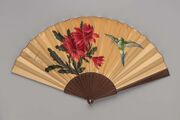Difference between revisions of "Hornbeam"
Jump to navigation
Jump to search
(username removed) |
|||
| (One intermediate revision by the same user not shown) | |||
| Line 1: | Line 1: | ||
| − | == | + | [[File:SC12106.jpg|thumb|Fan with hornbeam sticks<br>MFA# 1976.370]] |
| + | ==Description== | ||
| + | Hardwood trees in the flowering plant genus ''Carpinus'' that occur across much of the temperate regions of the Northern Hemisphere, such as the American hornbeam (''Carpinus caroliniana'') and European hornbeam (''Carpinus betulus''). Hornbeams yield a very hard timber, giving rise to the name "ironwood".[11] Dried heartwood billets are nearly white and are suitable for decorative use. For general carpentry, hornbeam is rarely used, partly due to the difficulty of working it. The wood is used to construct carving boards, tool handles, hand planed soles, coach wheels, piano actions, shoe lasts, and other products where a very tough, hard wood is required. The wood can also be used as gear pegs in simple machines, including traditional windmills | ||
| − | Schoch, W., Heller, I., Schweingruber, F.H., Kienast, F., 2004:[http://www.woodanatomy.ch/ Wood anatomy of central European Species]: Hornbeam, [http://www.woodanatomy.ch/species.php?code=CPBE Carpinus betulus L.] | + | ==Physical and Chemical Properties== |
| + | * Heartwood is pale yellow; the very thick sapwood with nearly white; most commercial wood is sapwood | ||
| + | * Grain is straight with a fine, even texture | ||
| + | * Resistant to wear, but susceptible to insects and weathering. | ||
| + | |||
| + | ==Working Properties== | ||
| + | * Difficult to work on account of its density and toughness. | ||
| + | * The density, coupled with fine and even grain, makes an excellent turning wood. | ||
| + | * Stains, glues, and finishes well. | ||
| + | |||
| + | ==Resources and Citations== | ||
| + | * The Wood Database: [https://www.wood-database.com/european-hornbeam/ European hornbeam] | ||
| + | |||
| + | * Schoch, W., Heller, I., Schweingruber, F.H., Kienast, F., 2004:[http://www.woodanatomy.ch/ Wood anatomy of central European Species]: Hornbeam, [http://www.woodanatomy.ch/species.php?code=CPBE Carpinus betulus L.] | ||
| + | |||
| + | * Wikipedia: [https://en.wikipedia.org/wiki/Hornbeam Hornbeam] | ||
[[Category:Materials database]] | [[Category:Materials database]] | ||
Latest revision as of 14:04, 9 September 2022
Description
Hardwood trees in the flowering plant genus Carpinus that occur across much of the temperate regions of the Northern Hemisphere, such as the American hornbeam (Carpinus caroliniana) and European hornbeam (Carpinus betulus). Hornbeams yield a very hard timber, giving rise to the name "ironwood".[11] Dried heartwood billets are nearly white and are suitable for decorative use. For general carpentry, hornbeam is rarely used, partly due to the difficulty of working it. The wood is used to construct carving boards, tool handles, hand planed soles, coach wheels, piano actions, shoe lasts, and other products where a very tough, hard wood is required. The wood can also be used as gear pegs in simple machines, including traditional windmills
Physical and Chemical Properties
- Heartwood is pale yellow; the very thick sapwood with nearly white; most commercial wood is sapwood
- Grain is straight with a fine, even texture
- Resistant to wear, but susceptible to insects and weathering.
Working Properties
- Difficult to work on account of its density and toughness.
- The density, coupled with fine and even grain, makes an excellent turning wood.
- Stains, glues, and finishes well.
Resources and Citations
- The Wood Database: European hornbeam
- Schoch, W., Heller, I., Schweingruber, F.H., Kienast, F., 2004:Wood anatomy of central European Species: Hornbeam, Carpinus betulus L.
- Wikipedia: Hornbeam
